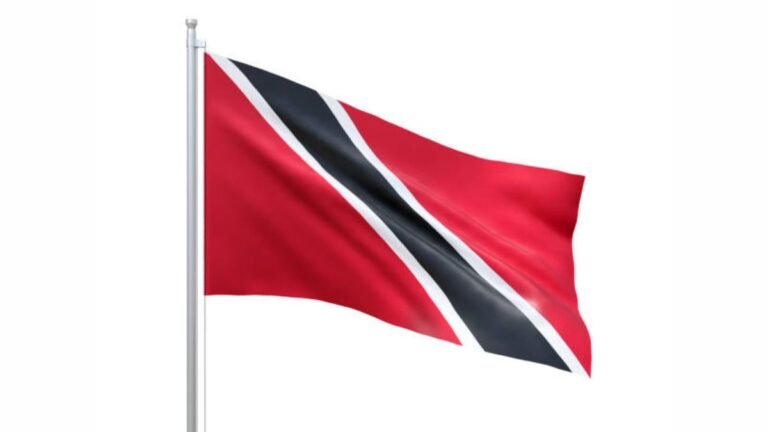The Trinidad and Tobago flag is a powerful symbol of national identity and pride, representing the island nation’s rich cultural heritage and history. This article explores the origins, symbolism, and significance of the Trinidad and Tobago flag, while providing you with essential insights into its history and what it stands for. Additionally, we will include a comparative chart for those interested in learning about similar flags around the world.
Origins of the Trinidad and Tobago Flag
The Trinidad and Tobago flag was officially adopted on August 31, 1962, when the country gained its independence from Britain. Designed by Carlisle Chang, a well-known Trinidadian artist and designer, the flag reflects the nation’s vibrant culture and diverse heritage.
Design Features
The Trinidad and Tobago flag features a bold, diagonal stripe running from the top hoist side (left) to the bottom fly side (right). The flag’s primary colors—red, black, and white—carry deep meanings:
- Red symbolizes the dynamism, energy, and vitality of the nation, as well as the courage and strength of its people.
- Black represents the commitment to the land, the people’s resolve, and the island’s rich history, rooted in both the African and indigenous heritages of the population.
- White symbolizes purity, justice, and the unity that binds the citizens of Trinidad and Tobago together, despite the diversity in their backgrounds.
The diagonal band that divides the flag into two sections represents the dynamic progress the country is striving to achieve. The red field takes up the larger portion of the flag, while the black band is outlined by a thin white border, signifying unity and harmony among the people of the twin islands.
Symbolism Behind the Trinidad and Tobago Flag
The Trinidad and Tobago flag is filled with meaningful symbolism that reflects the country’s values, traditions, and aspirations.
- The Diagonal Red Stripe: The bold diagonal red stripe in the flag’s design is a powerful symbol of the nation’s dynamic energy and forward-thinking. The direction from left to right indicates movement towards a better future, a vision held by the citizens of the country.
- Black: The black color on the flag speaks to the historical struggles of the people of Trinidad and Tobago, particularly the African, East Indian, and indigenous populations. It reflects the strength and resilience of these communities, as well as their ongoing fight for equality and justice.
- White: The white symbolizes peace, unity, and the ideal that coexistence among different groups can lead to a prosperous future. This speaks to Trinidad and Tobago’s multicultural society, where people of different ethnicities, religions, and backgrounds live in harmony.
The Meaning of the Flag in Contemporary Context
Today, the Trinidad and Tobago flag stands as a symbol of national pride for the people of Trinidad and Tobago. It is often displayed during national holidays, celebrations, sporting events, and public demonstrations. The flag is a reminder of the country’s unity and its ongoing pursuit of progress and prosperity.
How the Flag Compares to Other Flags in the Caribbean
The Trinidad and Tobago flag shares certain features with other flags in the Caribbean region, yet it also stands out due to its unique design. Here’s a comparative analysis of the Trinidad and Tobago flag alongside other notable Caribbean flags.
| Flag | Colors | Symbolism | Notable Feature |
| Trinidad and Tobago | Red, Black, White | Red: Vitality, Black: Strength, White: Unity | Diagonal black stripe crossing a red field |
| Barbados | Blue, Yellow | Blue: Ocean and sky, Yellow: Land and natural wealth | A trident head in the center |
| Jamaica | Green, Yellow, Black | Green: Agriculture, Yellow: Sun, Black: Strength | Bold diagonal stripes forming an “X” |
| Saint Lucia | Blue, Yellow, Black | Blue: Caribbean Sea, Yellow: Sunshine, Black: Strength | A distinctive upward-pointing triangle design |
| The Bahamas | Aquamarine, Yellow, Black | Aquamarine: Natural resources, Yellow: Sun, Black: People | A bold black triangle on the hoist side |
Key Similarities:
- Many Caribbean flags feature colors that represent the land, people, and natural resources.
- The use of diagonal stripes and other geometric patterns is common in Caribbean flag designs, symbolizing movement, progress, and the unity of the nations.
Key Differences:
- The Trinidad and Tobago flag stands out for its bold diagonal stripe design, while other Caribbean flags, such as Jamaica’s, employ a distinct “X” pattern.
- Some Caribbean flags, like Saint Lucia, use geometric shapes such as triangles, which is less prominent in the Trinidad and Tobago flag.
Trinidad and Tobago Flag in National Celebrations
The Trinidad and Tobago flag plays a prominent role in the nation’s celebrations and national events, often appearing in public spaces during:
- Independence Day (August 31st): A key national holiday marking Trinidad and Tobago’s independence from British rule in 1962. The flag is proudly displayed across the islands.
- Republic Day (September 24th): Celebrating the day the country became a republic in 1976. The flag is flown alongside national monuments and public buildings.
- Carnival: The world-famous Trinidad and Tobago Carnival showcases the country’s rich cultural diversity, and the flag often appears in vibrant parades, dances, and performances.
- National Pride: The flag is also used to display national pride during international sporting events, particularly in track and field, cricket, and soccer, where athletes represent the nation globally.
The Flag in the Digital Age: Online and Social Media Presence
In the digital age, the Trinidad and Tobago flag has become more than just a physical symbol of national pride. It’s now an iconic image used in social media, marketing, and digital content to signify connection with the nation.
Use in Social Media:
On platforms like Twitter, Instagram, and Facebook, the Trinidad and Tobago flag is frequently used by citizens to showcase their patriotism. People use the flag to celebrate major national events or when sharing memories of their homeland. The flag is also a symbol of the unity and strength of the Trinidadian people, often appearing in profile pictures and hashtags such as #TrinidadandTobago, #TriniPride, and #TnT.
Use in Merchandise and Marketing:
The Trinidad and Tobago flag is often found on merchandise like clothing, bags, and souvenirs sold by local businesses. During Carnival and Independence Day, companies and artists create limited-edition products that showcase the flag’s striking colors and unique design.
Flag Etiquette in Trinidad and Tobago
Like most nations, Trinidad and Tobago has specific guidelines for how the Trinidad and Tobago flag should be treated. The Flag and Coat of Arms Regulations govern its use, ensuring the flag is shown with respect and dignity.
Key Flag Etiquette Rules:
- The flag should never touch the ground.
- It should always be flown high and prominently in public spaces during national celebrations.
- The flag should never be altered, including the use of inappropriate symbols or designs over it.
- When displayed alongside other national flags, the Trinidad and Tobago flag should be of equal size and flown in a position of honor.
Conclusion
The Trinidad and Tobago flag is a symbol of the nation’s history, its people, and its aspirations. Through its dynamic design, it captures the country’s resilience, unity, and commitment to progress. The flag is not just a national emblem; it represents a deep connection to the island nation’s rich cultural heritage and diverse society.
From its adoption on August 31, 1962, to its contemporary use in celebrations and digital platforms, the Trinidad and Tobago flag continues to be a powerful symbol of national pride. Whether displayed during the vibrant festivities of Carnival or flown on Independence Day, it reminds citizens of their shared heritage and their journey towards a brighter future.

